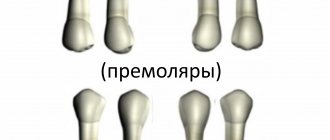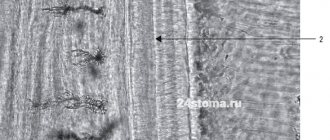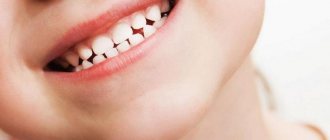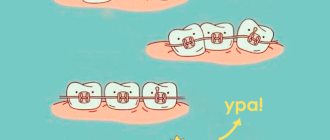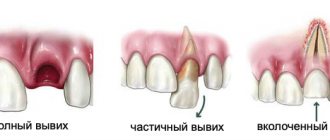In order to maintain the beauty and health of a child’s teeth, parents, first of all, need to know their structure, as well as have an idea of how temporary teeth differ from permanent teeth, and what care they require. This will help you avoid many mistakes, saving your baby from unpleasant sensations and negative emotions, and you from unnecessary troubles and worries.
Why do we need baby teeth?
It's no secret that baby teeth perform their function for an average of 10 years, after which they are replaced by molars. If we compare this figure with the average human life expectancy, it turns out that we spend almost all our time with molars. What then is the function of baby teeth? Generally speaking, baby teeth are one of the main components of the proper development of the facial skeleton. As for the details, they are presented below.
- Milk teeth provide chewing load.
The bone tissue of the jaw is formed only under the influence of mechanical pressure. Milk teeth provide the necessary load, thanks to which the harmonious development of bone tissue and jaw bones occurs. - They form a bite.
If a child’s primary bite has any abnormalities, this will inevitably affect the permanent teeth in the future. That is why it is recommended to regularly show the child to the orthodontist until the complete change of the dentition. - They are the “progenitors” of molars.
The rudiments of molars are formed under the temporary teeth, and the milk teeth are a kind of navigators that determine the place of the permanent ones. A correctly formed row of baby teeth means that molars are likely to appear in their place. - Participate in the formation of diction.
Milk teeth are part of the speech apparatus and are directly related to the reproduction of sounds.
Milk and molar teeth: what are their differences?
Externally, baby teeth and molars are very similar, but if you look closely, you will notice some visual differences: baby teeth are smaller in size, and the incisors and canines have a more rounded shape. The main differences are related to anatomy and structure.
- Primary teeth have thinner enamel with less mineralization.
- The root canals of baby teeth are much wider and, accordingly, more susceptible to the entry of pathogenic bacteria.
- The dentin layer of baby teeth is thinner, and the pulp is thicker.
- Milk teeth have roots, but they are less pronounced and dissolve during the process of changing the dentition.
Features of the root system of children's teeth
The structure of all dental canals includes coronal, middle and apical (apical) parts. The first, represented directly adjacent to the mouths, is the largest and widest. The middle part connects the coronal region with the apical zone of the root. The apical region is located below and often has a number of anatomical features: pathological or physiological resorption, fusion of several canals, lateral placement or open structure of the hole, strong narrowing or bending, ramification (branching), etc. The narrowest part of the root is located at the dentinocemental border. At a distance of 0.5-1 mm from the radiological apex there is a physiological opening. At an early age, root canals do not have a perfectly round cross-section. Only with age, due to the deposition of replacement dentin, its internal space takes on the shape of a circle.
When do baby teeth appear?
The formation of a child’s teeth begins in the womb: this is partly why doctors recommend that pregnant women eat foods rich in calcium and other beneficial minerals. After birth, the first baby tooth (in the vast majority of cases, this is the lower incisor) appears when the baby is six months old. There are cases when the first teeth erupt already in the third month, and sometimes a child is already born with one or more teeth (among many peoples this is considered a lucky sign). Conversely, some children acquire their first teeth after reaching one year of age. Below you can see a table that shows the current timing of the appearance of baby teeth.
Milk teeth on the lower jaw
| Name of teeth | Age of appearance |
| Central incisors | 6 – 9 months |
| Lateral incisors | 10 – 14 months |
| Fangs | 17 – 21 months |
| Premolars | 13 – 16 months |
| Molars | 23 – 30 months |
Milk teeth on the upper jaw
| Name of teeth | Age of appearance |
| Central incisors | 8 – 11 months |
| Lateral incisors | 9 – 12 months |
| Fangs | 16 - 19 months |
| Premolars | 13 – 16 months |
| Molars | 25 – 32 months |
Disorders during the eruption of primary teeth
The most common timing for the eruption of baby teeth is listed above. It is optimal when, upon reaching the age of three, the child has a full set of primary teeth. If baby teeth erupt late, experts advise parents not to worry unnecessarily: a delay of 2 to 3 months is considered normal. If after this period the teeth do not appear, then you should consult a doctor who will examine the child’s oral cavity, take tests and take panoramic photographs of the jaw, after which it will be possible to draw certain conclusions about the reasons for this delay. This usually occurs due to a lack of minerals and vitamins, which is easily solved with the help of restorative therapy. It is much worse when the rudiments of baby teeth are simply absent. This occurs extremely rarely and is usually caused by genetic abnormalities, periodontal inflammation and mechanical damage. In this case, to properly distribute the chewing load and develop the jaw bones, it is necessary to wear a removable denture.
Features of the structure of the roots of temporary teeth
In almost every case of treatment, the dentist can observe various deviations from the standard norms of topographic anatomy. However, the greatest number of differences occurs between temporary and permanent teeth. The most common and well-studied features are the following:
- small size of roots and crowns;
- a noticeable difference in the diameters of the chewing surface and the equator;
- wide arrangement of canals at molars;
- smaller ratio of root length to crown height;
- increased volume of the intradental cavity;
- distal deviation of the root apices of the anterior teeth;
- small thickness of hard tissues (enamel, primary dentin);
- the minimum distance between the mesial and other pulp horns;
- large width of cone-shaped channels;
- dynamic change in root topography due to the formation of secondary dentin;
- strong connection between the periodontium and the pulp using “mixed tissue”;
- plasticity and a higher degree of protection against resorption;
- maintaining the normal functioning of the nervous network when 1/3 of the root is damaged;
- constant change in the apical part due to active development or resorption.
When do baby teeth fall out?
“Childhood is over,” some parents say to their children whose baby teeth have been replaced by molars. Of course, this statement is mostly in a humorous form, since the average age when a child’s dentition ends is 12 years. At this time, the time of adolescence begins - one of the most interesting and eventful periods of our lives. As is the case with the eruption of baby teeth, their loss does not have a clear age limit. For example, today dentists are increasingly noting the early appearance of a full set of molars (as early as 10–11 years), whereas 20–30 years ago this could occur in adolescence (at 14–15 years). The service life of each baby tooth is on average 3-4 years: before the process of changing the dentition begins, the roots of the baby teeth are absorbed, so their loss does not bring severe pain and discomfort to children. Below is a table with the approximate timing of the loss of different groups of baby teeth.
Milk teeth on the lower jaw
| Name of teeth | Drop time |
| Central incisors | 5 - 6 years |
| Lateral incisors | 7 - 8 years |
| Fangs | 9 - 10 years |
| Premolars | 10 - 11 years |
| Molars | 11 - 12 years |
Milk teeth on the upper jaw
| Name of teeth | Drop time |
| Central incisors | 7 - 8 years |
| Lateral incisors | 8 - 9 years |
| Fangs | 10 - 11 years |
| Premolars | 11 - 12 years |
| Molars | 12 - 13 years old |
**Note: The first molar becomes the sixth molar, which does not have a primary tooth and erupts on its own at the back of the jaw.
Features of the structure of the roots of permanent teeth
Patients over 7-10 years of age usually have a fully formed root canal system. However, for a child with permanent teeth whose parents have made an appointment with a pediatric dentist, the formation process may not be complete. In this case, the canals will have some features that are important to take into account when carrying out endodontic treatment. Common features for permanent teeth are the location of the root orifices under the tops of the crown tubercles. Another characteristic feature is the increased cut diameter in the bucco-oral direction compared to the mesiodistal one. Physiological narrowing is usually located at a distance of 0.5-1 mm from the anatomical opening. Also, permanent teeth have a system of lateral canals, which are located at different levels from the main ones.
In cases where the process of root formation has not yet been completed, the patient exhibits the following features:
- absence of replacement and secondary dentin;
- large volume of pulp and intradental cavity;
- smooth transition from the crown to a wide canal in single-rooted teeth;
- low degree of mineralization and small thickness of the canal walls;
- a significant amount of predentin, easily susceptible to deep infection;
- absence of apical constriction: the funnel-shaped part smoothly passes into the growth zone;
- short root length;
- oval cross-sectional shape of the canal in the apical region.
When starting any manipulations with root canals, the pediatric dentist must first determine their anatomical structure and individual characteristics, using radiography and other modern research methods.
Problems with changing teeth
As with the eruption of baby teeth, molars can also be difficult to erupt. Sometimes the crown part of the tooth does not appear completely or is completely hidden in the soft tissues. This situation is usually called retention: it can be caused by improper or too deep seating of the germ, as well as late loss of a baby tooth in its place. Just as in the case of baby teeth, a child may have no molar rudiments at all: this happens due to metabolic disorders, insufficient mineralization or damage to the rudiments at the intrauterine stage of development. This can also occur when infections and inflammations are transferred from baby teeth and in some other individual situations. This problem can only be corrected by prosthetics or implantation after reaching adulthood.
Root canal treatment in children
The roots of children's baby teeth are filled with a special paste. It has the ability to dissolve in parallel with the process of resorption of hard tissues. This is the only way to ensure that the order of changing teeth is not disrupted and that there are no obstacles to the resorption of milk roots.
Once the root canals are treated, they are closed with a filling. Sometimes the doctor decides to use temporary filling material. This measure is justified if the likelihood of complications is high and you need to make sure that the inflammation has subsided. Only when the dentist is sure that everything is in order will he install a permanent filling.
Milk teeth in adults: when childhood drags on
Yes, this happens, but very rarely. In dentistry, there are cases where baby teeth were found in thirty-year-old and even fifty-year-old people: doctors call such teeth persistent. What is the reason for such dental infantilism? This happens precisely for the reason that we talked about above. When a person lacks the rudiments of permanent teeth, the replacement mechanism does not start. Simply put, nothing puts pressure on the roots of baby teeth, which is why they do not dissolve, but remain in the oral cavity of an adult. It also happens that the rudiments of the molars are located too deep and also do not come into contact with the roots of the milk teeth. Treatment here is purely individual. If a person has a healthy baby tooth with intact roots, under which there is no molar rudiment, it makes sense to have it replaced with a veneer or crown in order to protect it from the external environment and give it the desired shape. If the baby tooth is unstable and its roots are resorbed, extraction is recommended. If there is a permanent tooth germ underneath, then it is “pulled” out; if not, a prosthesis is installed.
Milk teeth in children: structure, quantity, timing of eruption
Teeth (deciduous and permanent) are bone formations. They are designed to carry out the process of mechanical processing of food, the so-called mastication, in order to prepare it for subsequent digestion.
As for the anatomical structure of baby teeth, it is in many ways similar to the structure of adult teeth, although there are some important differences.
The part of the tooth located above the gum is called the crown. The surfaces of the crowns can be of different shapes depending on which particular tooth we are talking about, but in any case, in baby teeth they are much smaller in size.
The crown is connected to the root through a neck - a slightly narrowed part, around which connective fibers are located in the horizontal plane, forming the so-called circular ligament.
The root itself is located in a small depression called the alveolus. Vessels that supply nutrition to the tooth and nerves pass through a special hole in the apex of the root. Most people are mistaken in believing that baby teeth do not have roots. In fact, those of them that are intended for chewing food (molars) are also molars, only their roots are independently absorbed by the time they are replaced by permanent ones.
What is inside the crown? A photo of the structure of a baby tooth helps you find out:
- Any milk tooth, like a permanent one, is covered with enamel.
Only in temporary teeth it is much thinner and softer, and not so mineralized, which is why in children caries develops rapidly and can turn into pulpitis or periodontitis in a few weeks.
- Beneath the enamel is dentin, which is also much thinner than in permanent teeth.
This is the highly mineralized underlying tissue surrounding the tooth cavity and root canal. It is slightly inferior in strength to enamel. Dentin in the direction from the center is completely pierced by special tubules, through which impulses are transmitted and all metabolic processes occur.
- Dentin, closer to the root system, covers cement, to which the fibers of the ligamentous apparatus - periodontium - are attached.
- The internal cavity of the crown and root of the tooth is filled with pulp - very soft internal tissue in which nerves and blood vessels are located.
It plays a major role in providing the tooth with nutrients and carrying out metabolic processes. When the pulp is removed, metabolic processes in the tooth become impossible.
In baby teeth, the volume of the pulp is much larger, and the root tubules are wider than in permanent teeth.
In addition to the structural features of baby teeth, parents are concerned about the timing of their eruption and how many teeth should be normal at a given age of the baby. Let's look at these questions in more detail.
Do baby teeth need to be treated?
If you have carefully read the article up to this point, then you should have no doubts. Baby teeth must be treated, since they are directly involved in the formation of the bite and the appearance of permanent teeth. If baby teeth are not treated and cared for properly, there is a high risk of early loss. The enamel of baby teeth is thin; it quickly succumbs to the pressure of carious bacteria and the destructive effects of the external environment. Moreover, the inflammatory process, having penetrated into the depths of a baby tooth, can damage the rudiments of a molar, and then you will lose not one, but two teeth at once. Monitoring the child’s hygiene and regularly taking him for preventive examinations is the task of every parent.
